For ideal male hormone production, you'll want to use red light therapy with wavelengths between 660-850nm, positioned 6-12 inches from your body. Start with 10-20 minute sessions daily or every other day for 4-6 weeks, then reduce to 1-3 weekly maintenance sessions. When targeting the testicles specifically, limit exposure to 2-5 minutes at 50mW/cm² with cooling breaks. You'll typically see testosterone improvements within two weeks, with levels potentially increasing from 2.1 to 3.6 ng/ml. Wear protective eyewear and follow device guidelines for safety. Understanding the complete protocol can help maximize your hormonal benefits.
Understanding Red Light Wavelength Benefits
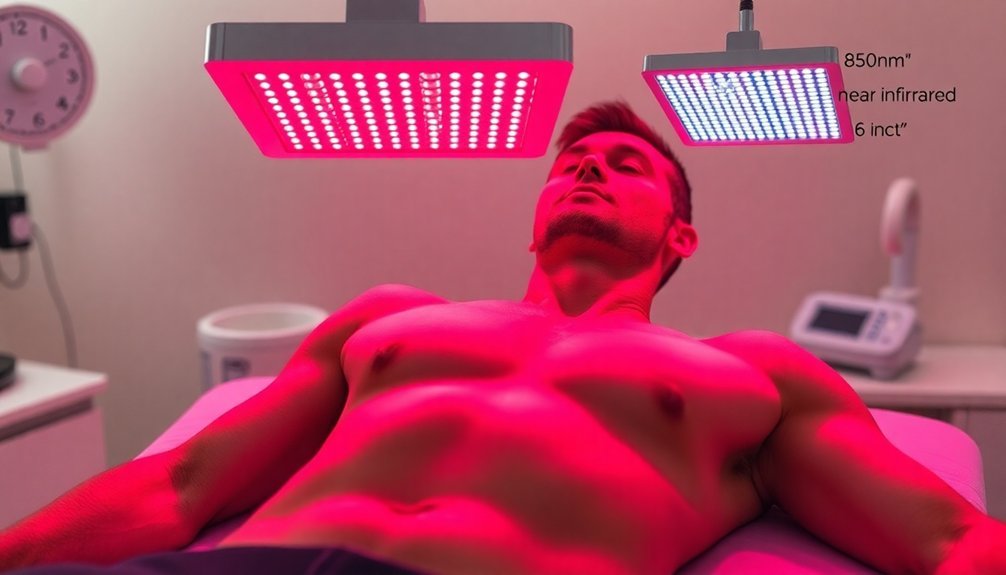
Through the precise application of red light wavelengths, specifically at 660 and 850 nanometers, your body receives powerful therapeutic benefits that directly impact hormone production. These wavelengths penetrate your tissues to stimulate cellular energy production, particularly in your Leydig cells, which are essential for testosterone synthesis.
When you expose your body to red light therapy, you'll trigger a biological response that enhances ATP production in your cells. Many men experience a 1-2% annual decline in testosterone production after age 30. This increased cellular energy directly supports your hormone regulation system, helping to balance testosterone and estrogen levels while reducing inflammation throughout your body.
You'll find that red light therapy doesn't just target testosterone production – it's working on multiple hormonal pathways. It helps regulate your cortisol levels, supports your thyroid function, and can increase your melatonin production.
The therapy's interaction with your pineal gland further supports your reproductive health and overall hormonal balance.
What makes this therapy particularly appealing is its safety profile. You won't experience DNA damage, and the treatment is completely non-invasive. By combining red and near-infrared wavelengths, you're accessing a scientifically proven method to enhance your hormonal health naturally.
Optimal Treatment Duration
Now that you understand how red light therapy works at the cellular level, getting the timing right maximizes your hormonal benefits. You'll need to commit to 4-6 weeks of consistent treatment during the initial phase, using sessions either daily or every other day. This jumpstarts your body's hormonal response and helps establish a baseline for improvement. Each session should last 10-20 minutes to effectively stimulate testosterone production.
| Phase | Duration | Frequency |
|---|---|---|
| Initial | 4-6 weeks | Daily/Every other day |
| Maintenance | Ongoing | 1-3 times weekly |
| Assessment | Every 3 months | Check progress |
After the initial phase, you'll shift to a maintenance schedule of 1-3 sessions per week. While this might seem like a significant time investment, it's considerably shorter than traditional hormone therapies, which can last up to 36 months. You'll need to maintain consistency to achieve the best results, but you can adjust the frequency based on your body's response.
Weekly Session Frequency Requirements
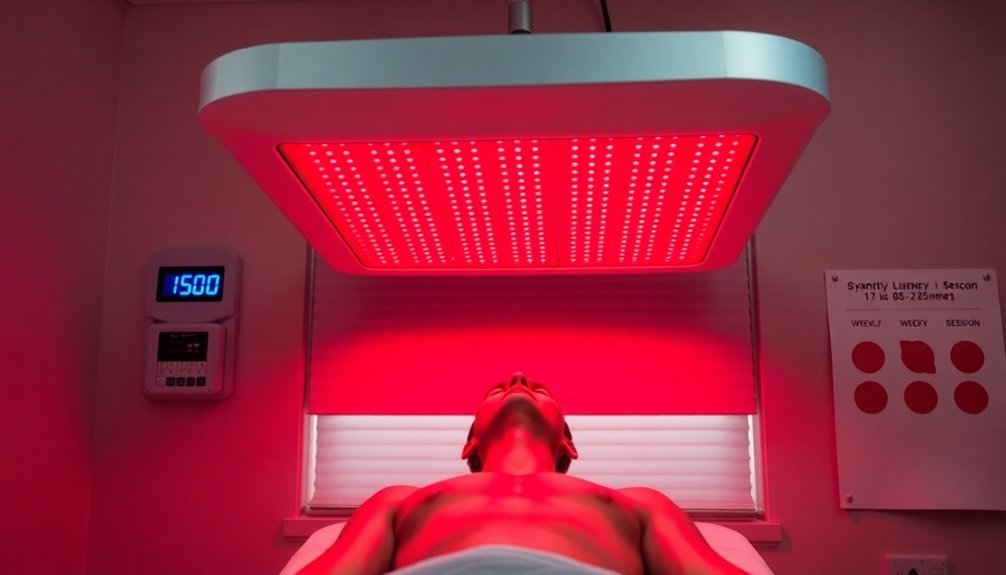
Determining the right weekly frequency for red light therapy sessions is essential for optimizing your hormone production. You'll need to commit to 3-5 sessions per week during your initial treatment phase, which may extend to daily sessions in some cases. Research shows that these sessions support cellular regeneration and repair at the tissue level.
This intensive schedule typically lasts 4-6 weeks to jumpstart your body's hormone regulation process.
Once you've noticed improvements in your testosterone levels and overall well-being, you can shift to a maintenance phase of 1-3 sessions weekly. You'll want to maintain consistency with your schedule, as regular exposure helps sustain the stimulation of Leydig cells and ATP production necessary for hormone synthesis.
Whether you're using a professional facility or an at-home device, each session should last 10-20 minutes using wavelengths between 660-850 nm. You'll get the best results by combining your red light therapy schedule with proper nutrition and exercise.
While this frequency guideline works for most men, you should consult your healthcare provider to create a personalized protocol that accounts for your specific health conditions and goals.
Direct Exposure Distance Guidelines
You'll get the best results from red light therapy by positioning the device 6 to 12 inches from your testicles during treatment sessions.
While closer distances can increase energy absorption, you shouldn't move closer than 6 inches to avoid potential skin irritation and overheating.
For optimal hormone benefits, treatment sessions should last 2 to 7 minutes when positioned at 6 inches from the light source.
Maintaining proper distance guarantees the best therapeutic benefits while staying within safe exposure limits that protect your reproductive health.
Optimal Distance For Results
For maximum effectiveness with red light therapy, maintaining the proper distance between your body and the device is crucial. You'll want to position yourself 6-12 inches away for maximum cellular absorption and tissue repair. This range guarantees the light penetrates deep enough to stimulate testosterone production through Leydig cell activation.
| Treatment Goal | Ideal Distance | Duration |
|---|---|---|
| Testosterone Enhancement | 6-12 inches | 2-7 minutes |
| Muscle Recovery | 6-8 inches | 10-15 minutes |
| Skin Health | 12-36 inches | 15-20 minutes |
When targeting hormonal benefits, you shouldn't exceed 120 joules of exposure per session, which typically means keeping your sessions to 15-20 minutes at close range. You'll need between 10 and 40 joules of near-infrared light to effectively treat deeper tissues. If you're not seeing desired results, you can gradually decrease your distance from the device, but always start with greater distances and work your way closer. For consistent hormonal benefits, you should aim for treatment sessions 3 times per week or once daily, using a combination of red LED waves (630-700nm) and NIR waves (700-900nm).
Close Vs Far Exposure
Light exposure distance plays a critical role in maximizing red light therapy's hormonal benefits. You'll want to maintain a distance of 6-12 inches from the light source to your treatment area for optimal results. This range guarantees effective light penetration while preventing excessive heat exposure.
For testicular treatment specifically, position yourself 6-12 inches from the light source with an intensity of 50mW/cm2. You shouldn't exceed 2-5 minutes per session, and you'll need to allow cooling periods between treatments.
If you're targeting multiple areas, like muscles and joints, stay within 6-8 inches for deeper penetration, while general wellness applications work better at 8-12 inches.
The biological mechanisms behind red light therapy depend on proper distance to function effectively. When you're too far, you won't activate the essential photoreceptive proteins and Cytochrome C Oxidase in your cells.
When you're too close, you risk overheating, which can harm testicular function. You can adjust these distances slightly based on your device's specifications, but don't exceed 30 minutes of total exposure time, as this can counteract the therapy's benefits through excessive heat buildup.
Safety Margins For Therapy
Maintaining proper safety margins during red light therapy sessions requires strict adherence to protective guidelines and distance protocols. You'll need to wear protective goggles during each session to prevent potential eye damage, especially when using higher-intensity devices.
Don't attempt treatments without proper medical supervision if you're using professional-grade equipment.
If you have a history of skin cancer or are taking medications that increase skin sensitivity, you must consult your healthcare provider before starting treatment. You'll need to follow the manufacturer's guidelines strictly regarding exposure duration and frequency.
Don't exceed recommended session times, as this won't improve results but may increase risks.
Watch for signs of skin irritation, such as redness or blistering, which can occur with excessive exposure or if you position yourself too close to the device. You should immediately stop treatment and adjust your distance if you experience any discomfort.
While red light therapy is generally safe when used correctly, you'll need to maintain consistent safety practices, including regular monitoring of your skin's response and keeping appropriate distance from the light source as specified in your device's manual.
Morning Versus Evening Application
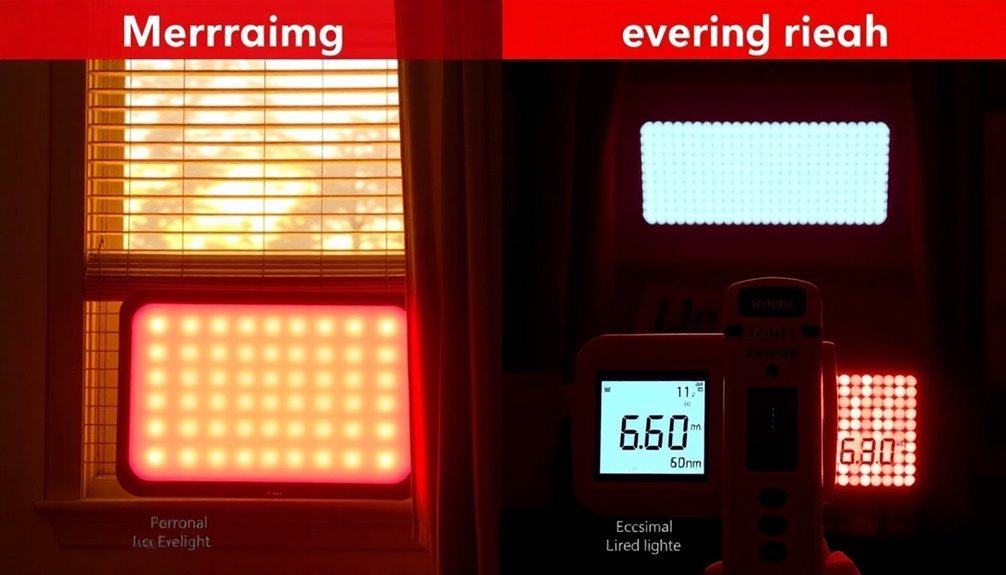
The choice between morning and evening red light therapy sessions can substantially impact your hormonal response and overall treatment effectiveness.
Morning applications align better with your circadian rhythm and natural light exposure patterns, potentially enhancing your body's hormone production and regulation throughout the day. You'll likely experience enhanced energy levels and improved metabolic function when you opt for morning sessions.
While evening sessions can help reduce cortisol levels and promote relaxation, they might interfere with your sleep quality if done too close to bedtime. If you choose evening applications, schedule them at least 2-3 hours before sleep to minimize potential sleep disruptions.
You'll need to be particularly mindful of session duration regardless of timing, keeping treatments between 2-5 minutes to prevent overheating.
For best results, you should maintain consistent timing with your chosen schedule. Whether you select morning or evening sessions, stick to 3-5 treatments per week. Consider starting with more frequent sessions during the initial 4-6 weeks, then shift to a maintenance phase of 1-3 weekly sessions once you notice improvements in your hormone levels.
Testosterone Production Time Frame
Men seeking hormonal benefits through red light therapy can expect to see measurable increases in testosterone levels within two weeks of consistent treatment. Research from the University of Siena demonstrates that testosterone levels can rise from 2.1 ng/ml to 3.6 ng/ml during this timeframe when following proper protocols.
You'll need to commit to 10-20 minute sessions, three to four times per week, to achieve ideal results. The therapy works by stimulating your Leydig cells, which are responsible for testosterone production in your testicles.
Through enhanced ATP production and increased mitochondrial activity, these cells become more efficient at secreting testosterone.
For the best outcomes, you'll want to use wavelengths between 660-850 nm, as these have proven most effective for hormonal stimulation. You can amplify your results by combining red light therapy with supplements like D-aspartic acid and fenugreek.
Clinical studies confirm that this approach not only boosts testosterone levels but also improves overall sexual satisfaction. The benefits extend beyond the initial treatment period, contributing to long-term hormonal balance and enhanced well-being when maintained consistently.
Safety Protocols During Treatment
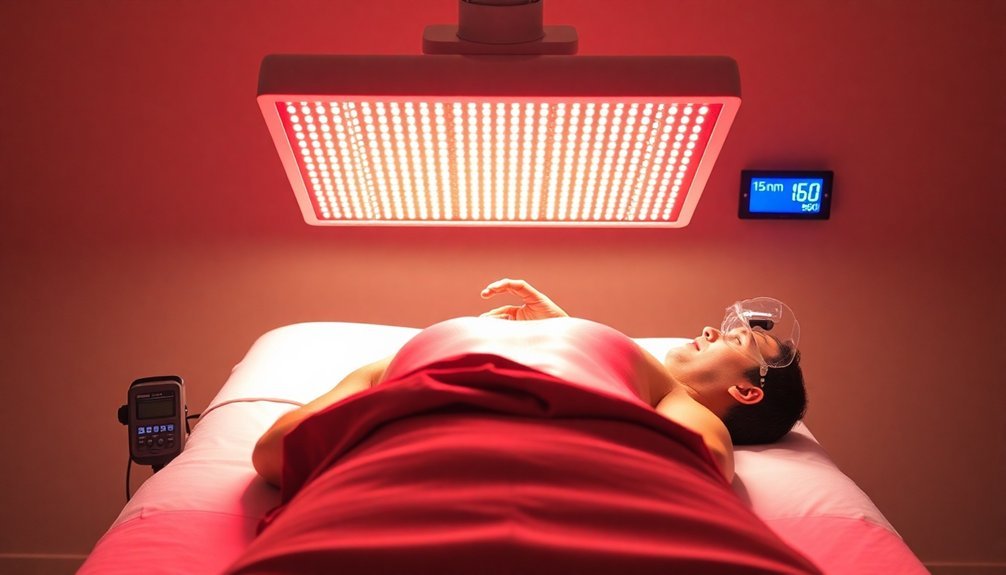
Position your red light therapy device at the manufacturer's recommended distance, typically 6-12 inches from the treatment area, to guarantee maximum light penetration without risking overexposure.
You'll need to wear protective eyewear specifically designed for red light therapy during each session, even if you're not directly treating facial areas.
For testicular treatment, limit your sessions to 2-5 minutes with proper device positioning to prevent overheating, and maintain a consistent treatment schedule as advised by your healthcare provider.
Proper Equipment Positioning Protocol
Proper setup and positioning of red therapy equipment plays a vital role in both safety and treatment effectiveness. You'll need to position the device close to and directly facing your treatment area, whether you're sitting or standing.
Make certain the device is securely strapped in place if it comes with attachment options.
Before beginning treatment, remove any clothing, jewelry, or accessories from the treatment area. If you're treating your face, take off glasses and contact lenses, and keep your eyes closed during the session.
For ideal results, verify your skin is clean and free from any products like makeup or oils that could interfere with light penetration.
You'll want to perform a sensitivity test before your first full treatment to check for any adverse reactions. During facial treatments, always use protective eyewear.
Don't use the device over areas with known skin conditions, allergies, or photosensitivity. If you're treating multiple body parts, maintain consistent positioning throughout each session.
Remember to clean your device with alcohol wipes after each use, and store it properly in its carrying pouch to maintain its effectiveness.
Safe Distance and Duration
After setting up your equipment correctly, understanding safe distance and duration parameters becomes your next priority for effective treatment.
Maintain proper distance from the device to prevent excessive heat exposure, which can inhibit testosterone production. Avoid direct skin contact with the LED panels and follow your manufacturer's specific distance guidelines for ideal light absorption.
Start with 10-15 minute sessions and gradually increase the duration based on your tolerance. You'll achieve better results through consistent, shorter sessions rather than sporadic, lengthy treatments. Monitor your comfort level during each session and adjust accordingly.
For the best results, use devices that emit wavelengths in the mid-600s to mid-800s nanometer range, with 670nm being particularly effective for male reproductive health. Consider combination therapy using both red LED waves (630-700 nm) and NIR waves (700-900 nm) for enhanced benefits.
Always consult a healthcare professional before starting treatment, especially if you have pre-existing conditions. Keep the treatment area at a comfortable temperature, as overheating can negatively impact testicular function. Remember that proper distance and duration management directly affects your treatment's success.
Protective Eye Gear Essentials
Safety demands appropriate eye protection during red light therapy sessions. You'll need to select protective eyewear that meets ANSI regulations and provides adequate protection against specific wavelengths used in your treatment. For maximum safety, make certain your protective gear features polycarbonate lenses, which offer both durability and optical clarity.
| Protection Type | Key Features |
|---|---|
| Reusable Goggles | Adjustable straps, PTCE material, suitable for long-term use |
| Disposable Shields | Latex-free, hypoallergenic, single-use protection |
| Ocular Shields | Non-reflective exterior, mirror finish interior, conforming fit |
| Safety Glasses | Polycarbonate lenses, side protection, comfort bridges |
You'll want to inspect your protective eyewear before each session, checking for any damage or wear that could compromise its effectiveness. Remember that even low-powered red light can cause eye damage with extended exposure, so never skip this vital safety step. Your protective gear should fit comfortably and securely, with adjustable features to make sure it stays in place throughout your treatment. If you're using disposable shields, verify they're properly sealed and positioned before beginning your session.
Energy Output Measurements
Understanding energy output measurements is crucial when evaluating red light therapy's effectiveness for hormone optimization.
When you're using red light therapy, you'll want to monitor both the energy input and cellular response to guarantee top results.
The therapy's effectiveness is measured through specific wavelengths of 660 nm and 850 nm, which directly impact your cellular energy production. Your cells' mitochondria respond to these wavelengths by increasing ATP production, which you can track through various biological markers. While you can't directly measure ATP in real-time, you'll notice the effects through improved energy levels and hormone production.
To measure the therapy's energy output, you'll need to evaluate both the power (measured in watts) and exposure time (measured in hours). Modern smart meters can help you track the exact energy delivery to guarantee you're receiving the correct therapeutic dose.
For ideal hormone production, particularly testosterone, you'll want to monitor the energy reaching your Leydig cells. Clinical studies show that proper energy output measurements help achieve the best results, as the right dose directly correlates with increased testosterone levels and improved cellular function.
Combining With Other Health Practices
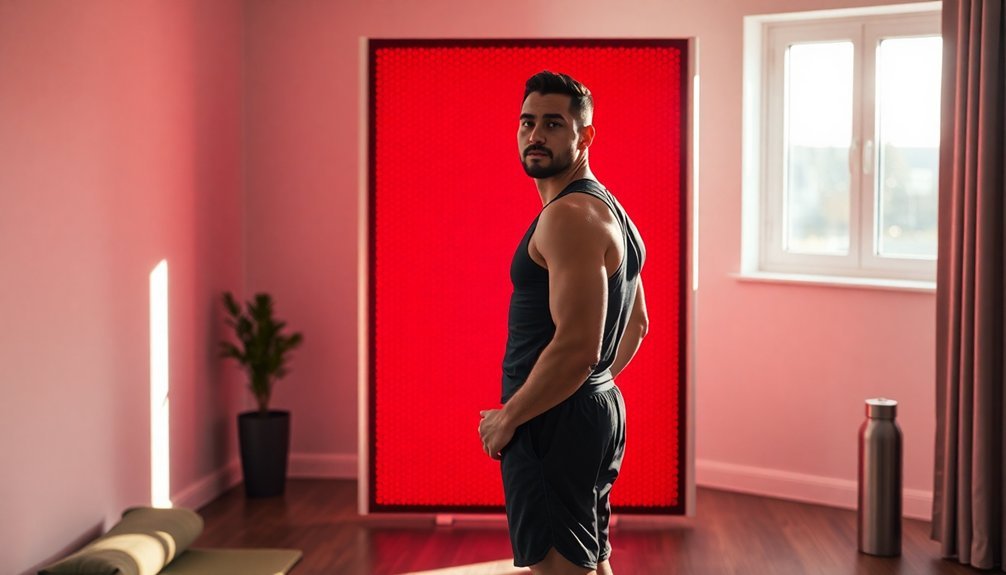
A thorough approach to red light therapy maximizes its hormone-boosting benefits when combined with other health practices. When you pair red light therapy with resistance training, you'll enhance muscle growth and strength while supporting testosterone production through increased ATP synthesis.
Your dietary choices also play a vital role – focusing on foods rich in omega-3 fatty acids, vitamin D, zinc, and magnesium can amplify the therapy's effectiveness.
- Regular exercise combined with red light therapy boosts ATP production in Leydig cells, essential for testosterone synthesis
- A balanced diet high in antioxidants protects against oxidative stress and supports the therapy's hormonal benefits
- Quality sleep and morning light exposure regulate circadian rhythms, optimizing testosterone production
Your sleep patterns substantially impact hormone levels, and red light therapy can help regulate your circadian rhythm when used consistently. Consider using the therapy in the morning to align with your body's natural hormone production cycle.
Additionally, incorporating stress-reduction techniques like meditation while maintaining a consistent red light therapy routine can create a synergistic effect on your hormone levels and overall well-being.
Results Tracking Methods
To harness the full potential of red light therapy for hormone optimization, tracking your results provides clear evidence of progress and helps refine your treatment approach.
You'll need to establish baseline measurements through blood tests that measure both total and free testosterone levels before starting treatment.
You can monitor your progress through regular serum testosterone assays, which offer the most accurate assessment of hormonal changes. Consider combining these with saliva tests, which specifically track free testosterone levels.
If you're participating in a clinical study, you'll likely undergo standardized testing protocols that include control groups and blinded assessments.
Keep a detailed log of your treatment sessions, including duration, frequency, and any noticeable changes in energy, libido, or mood.
Use standardized questionnaires to track symptom improvements systematically.
It's essential to maintain consistent testing intervals and conditions, such as getting blood work done at the same time of day and following similar pre-test protocols.
For thorough tracking, document sperm quality metrics if fertility is a concern, and work with healthcare providers who can interpret your results within the context of your overall health goals.
Frequently Asked Questions
Can Red Light Therapy Help With Erectile Dysfunction?
Yes, red light therapy can help with your erectile dysfunction by improving blood flow, boosting testosterone production, and enhancing sexual performance. It's a safe, non-invasive treatment that you'll typically need 3-4 times weekly.
Does Wearing Clothes During Treatment Reduce Its Effectiveness?
Yes, wearing clothes during red light therapy will reduce its effectiveness. You'll get the best results with direct exposure since clothing can block or absorb the light waves before they reach your target areas.
Should Treatment Be Avoided During Certain Medical Conditions?
Yes, you'll need to avoid red light therapy if you have recent burns, malignant cancers, fever, bleeding conditions, or photosensitivity. Always consult your doctor, especially if you're pregnant or have thyroid issues.
Can Women Safely Use Red Light Therapy for Hormone Balance?
Yes, you can safely use red light therapy to support hormone balance. It's proven to help regulate estrogen, progesterone, and melatonin levels. Just consult your healthcare provider first, especially if you're pregnant.
Do Different Body Parts Require Different Exposure Times for Optimal Results?
Yes, you'll need different exposure times based on skin thickness. Treat thinner areas like your face for 5-10 minutes, while thicker regions like your back and joints require 15-30 minutes for best results.
In Summary
You'll get the best hormone-boosting results from red light therapy by using wavelengths between 630-850nm for 10-20 minutes per session, 3-4 times weekly. Position yourself 6-12 inches from the device, and maintain consistency with morning treatments. Track your progress through regular hormone testing and symptom monitoring. While results vary, you should notice improvements within 8-12 weeks of consistent use when following proper protocols.





Leave a Reply